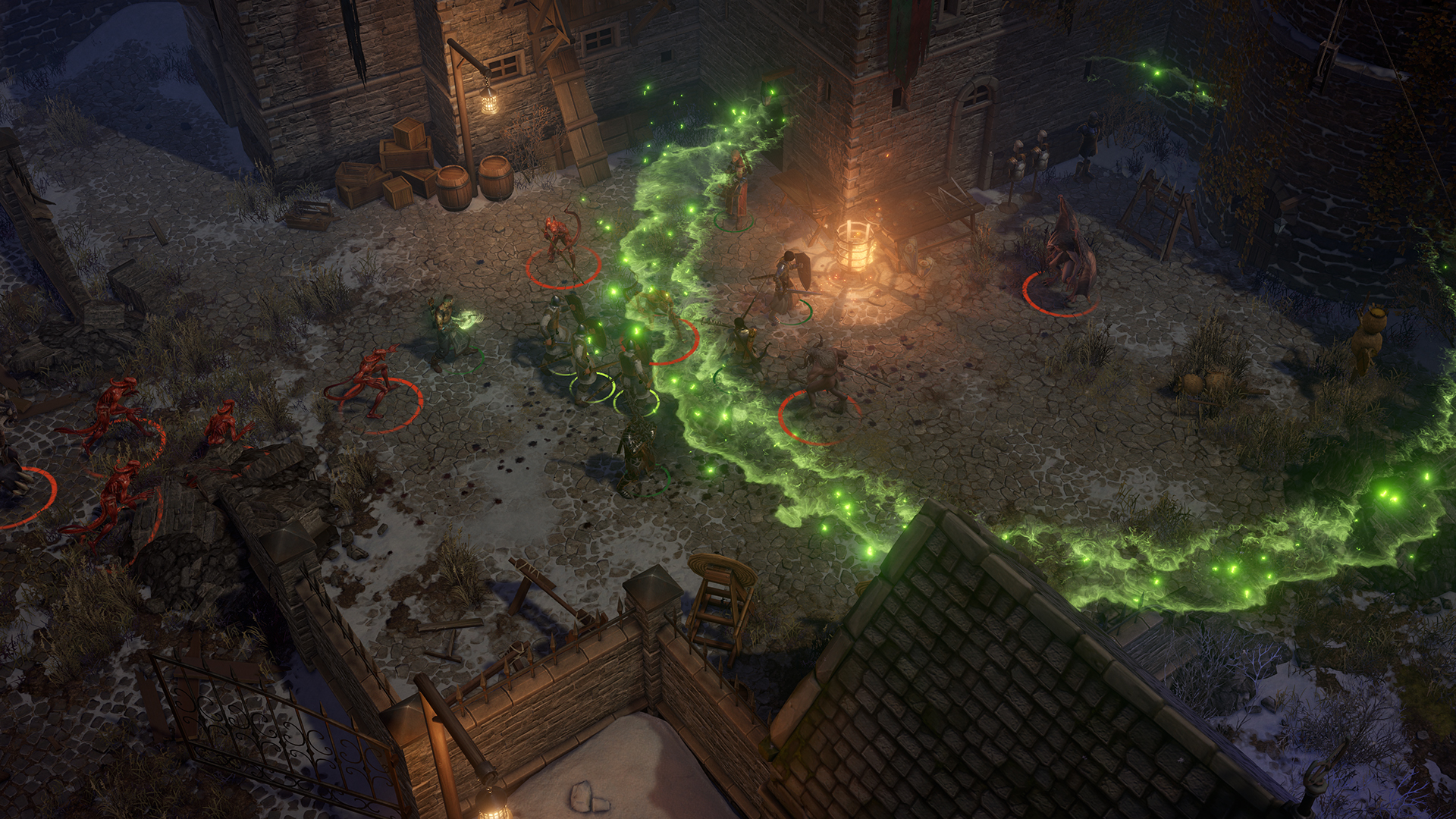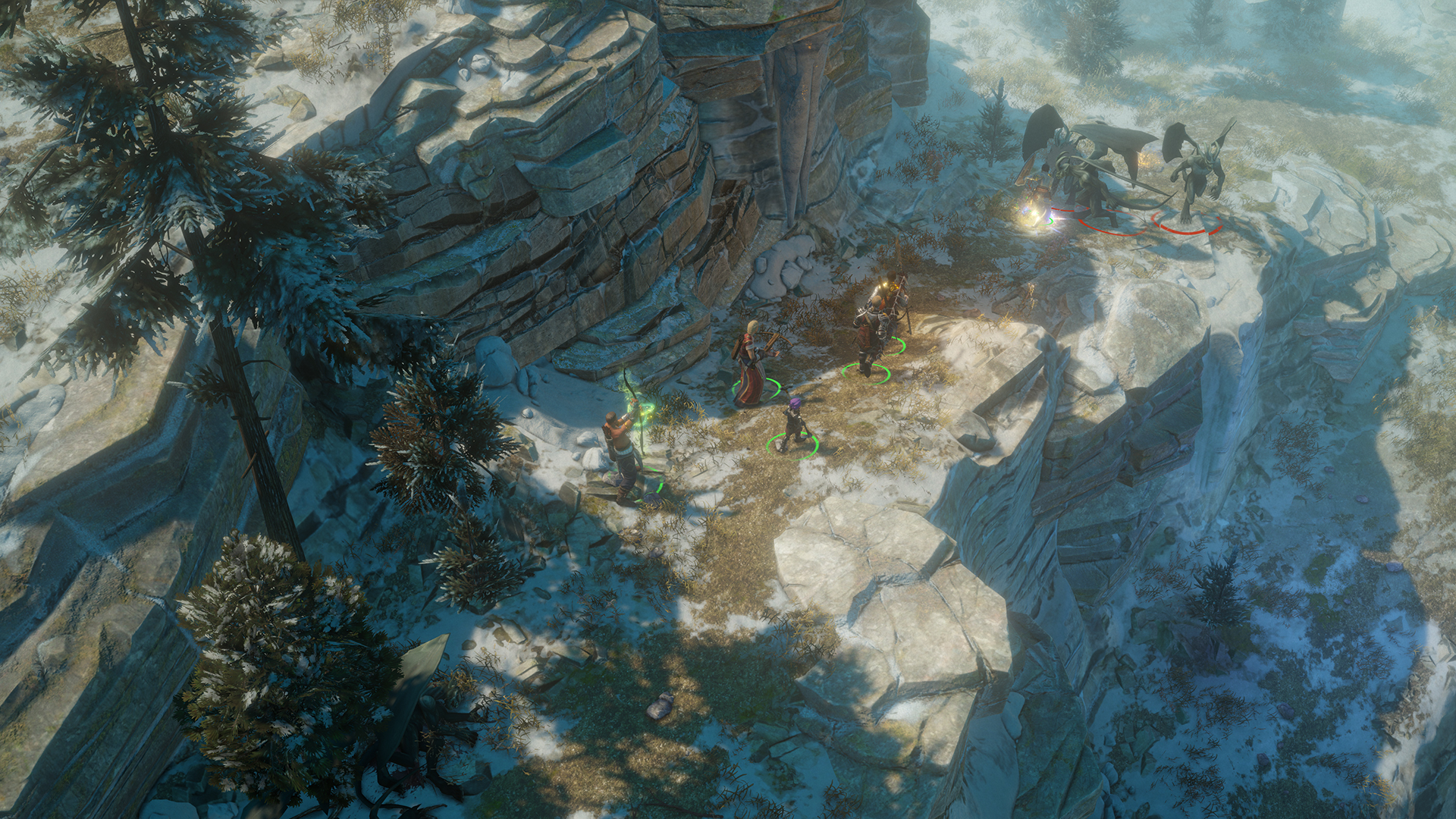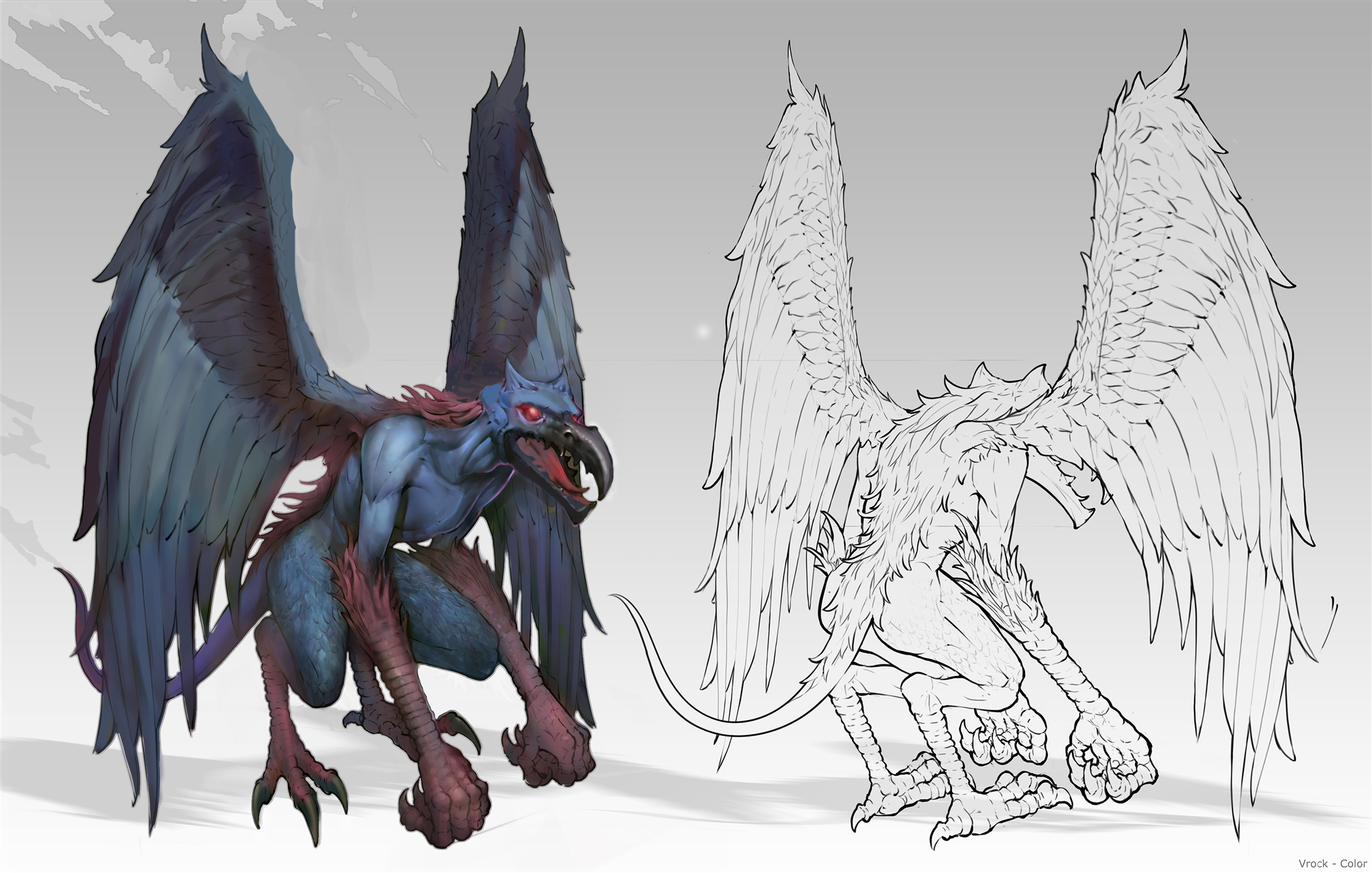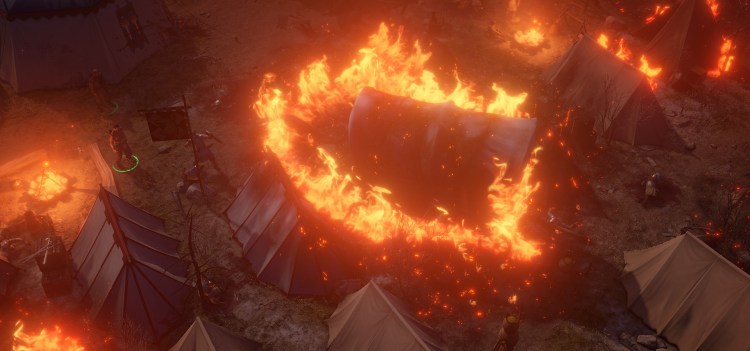GamesBeat: The Worldwound keeps popping up. What is it, and what role does it play in this story?
Mishulin: I can’t answer about the role of the Worldwound, because that would be spoiling everything. But the Worldwound, it’s a bit difficult to answer, because there are things that characters know, and then things that the game master knows, because it was written for the game master. The characters in the game know that a powerful sorceress opened a portal. She was contained in Threshold. Threshold was a kind of prison for mages in Sarkoris. Somehow she opened a portal to the demons in the center of this prison. In this particular place in Golarion, the Abyss and Golarion itself are rather close. In past times there were invasions by demons and a desperate fight to go through the veil between this point. It was stopped by Aroden back in time. But now it’s just a huge gap, and the Abyss is mixing with Golarion. It allows demons easy entrance, and also it’s like a home territory, so you can’t banish them back to their original plane. They can exist here easily.
Avellone: It’s a huge abyssal gate. It’s on Golarion, and all the demons pour out of it. The terrain has changed around it, where all the abyssal crap is bleeding out into the landscape. You get new insects, new vegetation, new weather patterns, and it’s all awful. It’s a pretty dark stain on the surface of Golarion.
Mishulin: It has a crucial role in the whole storyline, but I can’t go further than this.
June 5th: The AI Audit in NYC
Join us next week in NYC to engage with top executive leaders, delving into strategies for auditing AI models to ensure fairness, optimal performance, and ethical compliance across diverse organizations. Secure your attendance for this exclusive invite-only event.
GamesBeat: And there’s no similar Hellsmouth?
Mishulin: There are some very contained gates to the Hells, related ones in Kenabres, but that’s in other stories. Hell’s Rebels and Hell’s Vengeance are a pair of adventure paths that tell the story of crushing the rebellion and you’re playing with evil guys, or inciting the rebellion and playing with good guys. It’s an interesting story for another campaign.

Above: Babau demons want to rend your flesh in Drezen.
GamesBeat: Is Kenabres another town the demons have taken over? Or are they trying to?
Mishulin: At the beginning of the adventure, the demons attack Kenabres. At the center of Kenabres is a wardstone … a part of the safeguarded network that paladins, clerics, with the help of Iomedae, the goddess herself, put to prevent demons from spreading into the whole of Golarion. The demons attack the city, attack this wardstone. I could tell the story further, but you survive the initial attack on the city with the crusades, with some Mythic Powers. The path isn’t chosen there. The path is chosen in the second chapter. But you save Kenabres.
After that you visit Queen Galfrey, and she promotes you to be lord commander of the Fifth Crusade. That means you’ll be commanding the Crusade. We really liked how that worked strategically in Kingmaker. Apart from the mechanics and all that stuff, it also allowed us to showcase our campaign and see a different perspective as you were governing, how she has programs for growing her nation.
GamesBeat: Is this an effort by one nation, or does Queen Galfrey have the authority with a bunch of nations to establish this?
Mishulin: It’s an effort of Mendev, because they’re nearby. But a lot of followers of Iomedae flock into there to fight the demons, because it’s a noble goal. It’s protecting the whole world. Also, some countries support Mendev financially, especially the neighboring ones, because they understand what will happen if Mendev falls and the demons just flow out of there.
Avellone: There’s at least one kingdom, sort of the jackass kingdom in Kingmaker. They made a mention in the source material that they saw the First Crusade as an opportunity to get rid of a lot of asshole mercenary companies. “Hey, you guys wanna go on a Crusade? Just get the fuck out of our country.”
Mishulin: But because these crusades have happened for the last hundred years, people get tired. Especially during the Fourth Crusade, morale was rather low. A lot of lowlifes got into the crusades to get food and clothing and somehow avoid the military action, just to get away from their lives. It’s become a kind of stalemate at the beginning of the adventure. These are gargoyles here. You’ll be commanding the crusade, and that means you’ll be making some governmental decisions, similar to Kingmaker. But you’ll also be able to recruit an army and send them out on the world map to battle the demons and reclaim parts of the world map, maybe find some powerful artifacts to bring to the party and make them stronger.
Sage advice
GamesBeat: Will your party have adviser roles again?
Mishulin: Yes. There will be advisers. The Crusade itself is still very much in development. For the nation-building, we had eight versions, prototype designs and everything. For the Crusade we hope that there will be less prototyping involved. [Laughs] Everything I will be telling you about the Crusade is subject to change, still under development. When we prototype it it could change drastically.
But the current idea is you’ll be sending those groups across the world map and reclaiming some lands and finding some artifacts. As for battles themselves, it’s not like we’re playing a Total War experience, because it would be too much for one game to include everything. We actually discussed it early in the project, and we could pull it off in the engine, but if we’re doing that, we’re not doing anything else.

Above: Hell knights could be your fiend-loving friends.
And we really wanted our Mythics to be the key feature of the game. We wanted to tell more stories. We wanted to have more abilities and powers that are growing and reactions in the world as you become something out of legends. Because of that, we really scaled down the Crusade part. But there will still be battles, closer to old-school games like Warlords or something of that kind. A little bit more basic, but still with the same flavor.
Along the way you’ll be meeting new allies, trying to recruit them into your effort, or just pass by, or make some other decisions. Those are hell knights. The hell knights are battling the gargoyles over there. The first time you encounter them, they’re killing off the old and wounded that the paladins are protecting. It’s set them up, the hell knights, as tyrannical, structural, ruthless, efficient. It’s up to you to decide what you want to do about them. But in the long run, through the second chapter, you understand that the thing they did with the wounded — it’s not a good thing, but the gargoyles were taking the wounded to make undead out of them. The hell knights have figured out that the gargoyles are up to no good, and they were denying them resources in that way. It’s up to you to decide whether you support this, or whether you don’t agree with that and want to destroy the hell knights or otherwise do something about them.
GamesBeat: If the demons are making undead, does that mean you’re also talking about demon lords like Orcus, the Prince of the Undead, in this game? Or is it just that demons are smart and use resources?
Mishulin: It’s the second one. Of course we mention a lot of other demon lords. The leader of the gargoyles is a demon, and the gargoyles worship Kabriri, the first ghoul. Even the characters in the second chapter discuss that in the worst case scenario, another demon lord is entering the scene, but it turns out it was just a small outbreak of these types of demons. But yeah, the characters do understand the gravity of the situation. If you encounter some strange things sometimes, it’s probably a lead-up to a very powerful demon lord.
Mechanics vs. storytelling
GamesBeat: Does resting during an assault on a fortress kind of take you out of the assault?
Mishulin: Yes, but in the original adventure path, the assault takes you about several days. In the party that I was GMing, it took them about 15 days. For other parties it was longer or shorter. On the tabletop, there is a mechanic around how many crusaders you still have. It’s very difficult for the player to clear the entire map without resting. We didn’t just want to give you a few simple and boring fights. If we offer you this kind of challenge, we need to also give the opportunity to rest.
GamesBeat: As a writer, when you’re writing scenarios, do you take that into account, whether you want to break the immersion by letting the players rest?
Avellone: The expectation that you have watching this is that this is going to be a big immersive event and you’ll plow through the entire thing in like half a day of game time. But what we would do in that case, from a narrative standpoint, is we defeat that expectation. That’s a reaction the player may have, so we want to frontload — well, the siege of Drezen may take you several days, so make sure that you rest and take it in stages. We want to narratively set up a context where you don’t feel like the immediacy, where this is going to be several days of campaign. Because nothing is worse than dashed player expectations.

Above: The vrock is a bully, like many other demons. But it has some degree of power, too.
GamesBeat: One challenge I see with this game is, demons are scary, powerful foes. How do you make it to where players still respect their power when you’re killing them throughout the game?
Mishulin: We’re introducing different demons, and we devote special time for some of them. The first time you encounter a Vrock, it will be a miniboss, and there are also Vrocks with some dialogue. She was making sacrifices of captured crusaders to make herself the most powerful Vrock ever, but she’s kind of stupid. There are a lot of options for how to deal with her. You can just try to kill her, or you can trick her. There’s a special side stories that tricksters have with this Vrock, because they find the perfect opportunity for a lot of jokes we can pull off.
GamesBeat: Was that in the original adventure path, or did you come up with that?
Avellone: I didn’t do the Vrock encounter. That was one I heard about. It was hilarious.
Mishulin: The Vrock was initially in the book, and she’s not really smart, but she’s not really stupid. But we went after that beat and made her a bit more hilarious. We don’t want the game to be all just doom and gloom. We want it to have very different. We want you to experience different types of emotions. Some of the encounters are funny. Some of the encounters are more dark. The mythic paths themselves are very different in tone.
The crowd’s voice
GamesBeat: Is the narrative all locked in, or will anything change based on community feedback or Kickstarter goals?
Mishulin: Everything changes when we playtest things. We may have some additional input and information. Of course some of the goals in the Kickstarter that are tied to the storyline will be able to affect it. As for the second chapter, the main storyline of the second chapter, the choices and some of the consequences that are happening in the next chapter of the game, are already completed. But also some of the other types of choices, like companion stories … the beginning of the stories about the Mythic Paths, they’re not entirely in the second chapter yet. Mostly because they’re subject to change. We’re still figuring out the best way to do that.
GamesBeat: Chris, you’ve written for a number of games that have gone through crowdfunding. What is it about Kickstarter games and games that go through so much community feedback through development that attracts you?
Avellone: It removes the publisher being the sole person deciding what becomes the game narrative. Asking the players what they liked about Kickstarter and crowdsourcing in general, they feel like you’re asking the right people what kind of game. With a lot of the games, like isometric RPGs, it was almost impossible to get a publisher to fund them. They just didn’t make enough money for them. But there was a really passionate fanbase that did want to see games like that. If you’re doing a game that’s more modest in scope, versus multibillion-dollar stuff for every console and platform, being able to finance that directly, allowing them to contribute as much as they want, and seeing that happen was a huge breath of fresh air for me. It allows a wider variety of games to be made without insane budgets. If you want to have a Baldur’s Gate II experience, now we can make games like that. Asking the players to contribute on that kind of platform was the best way to get it done.
GamesBeat: Do any of the backer goals come from some of the internal tabletop campaigns you’ve ran?
Mishulin: When we started preproduction on the game, we had a huge list of things we wanted for various reasons. Enhancements in gameplay, some of the classes we wanted, some of the species we wanted. We took those and compared that to the amount of work we could put into the game, and it’s just like one-third of the list. We had to draw the line. We made our scope based on that. A lot of things and ideas were like, it would be really cool to have that, but we don’t have the opportunity right now to do so. Those are our stretch goals.
GamesBeat: Do stretch goals help you with the scope of your game, balancing the original version and what you want to do with it?
Mishulin: Yeah, they provide us with the opportunity to do so. We try to make the stretch goals so that we don’t blow the game out of proportion. We’re still trying to make those goals that allow us to release the game in a similar time frame to what we were thinking about. Maybe a couple of months later, but still on the same track. We try to provide goals that provide players more choices, more variety, more options.
GamesBeat: We’re going into a new decade. You have services like Game Pass. You have Apple Arcade. You have early access and Kickstarter and all these different models. What does that mean for RPGs going into the new decade?
Avellone: I don’t know if it changes them very much. I think Game Pass definitely has changed the consumer outlook, for sure. What’s encouraging to me is that the platform holders have said, “OK, we’re going to develop this PC RPG.” But because of things like Game Pass, there are still opportunities to do console ports like PlayStation and Xbox with Game Pass. Because those platforms need a continual influx of new games to keep people coming back to the platform, they’re more receptive. Yes, we’d love to see an Xbox version. We’d love to see a PS version. You also get that from the console publishers, because they want people coming back to the platform. That’s healthier than ever. I think Game Pass is a fantastic thing. It was pretty much inevitable that that sort of Netflix style service would be offered for games. It just works.


